Key takeaways:
- Building personal relationships with lawmakers is essential for effective lobbying, fostering a collaborative environment.
- Storytelling is a powerful tool for making climate issues relatable and urging lawmakers to take action.
- Connecting climate advocacy to the interests of policymakers enhances the effectiveness of lobbying efforts.
- Coalitions with diverse stakeholders amplify messaging and influence policy changes more effectively.
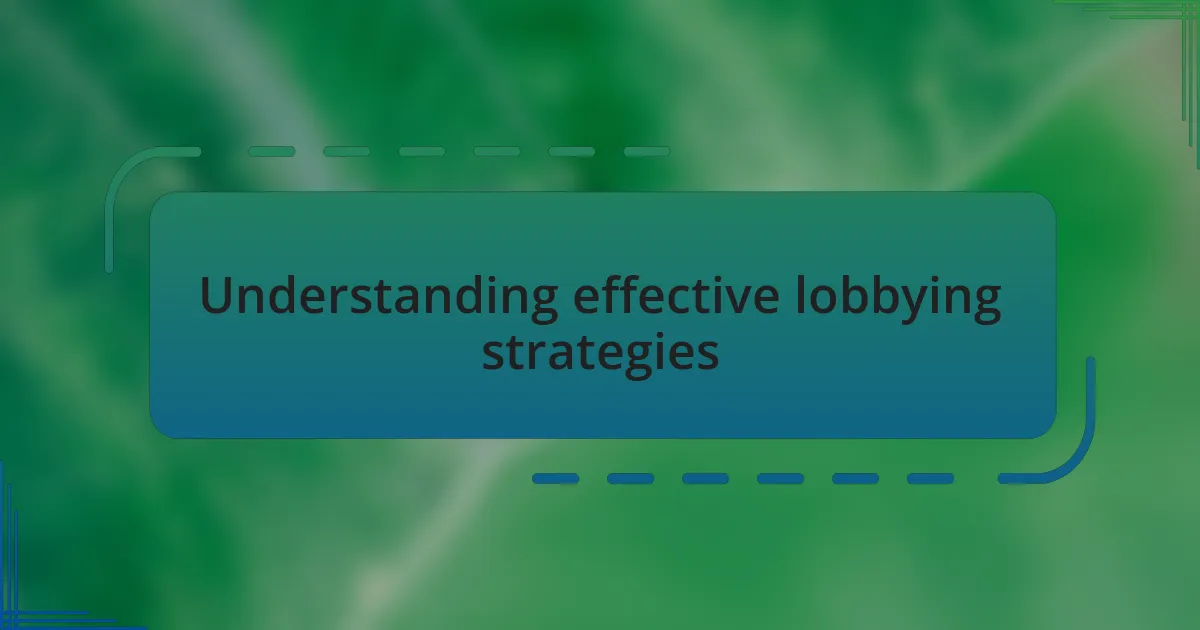
Understanding effective lobbying strategies
Effective lobbying strategies hinge on a solid understanding of the legislative process and the priorities of lawmakers. I remember once attending a meeting where a seasoned lobbyist emphasized the importance of building relationships. It was eye-opening to see how personal connections can open doors and create a more receptive environment for discussing vital issues.
One key aspect of effective lobbying is aligning your cause with the interests of policymakers. I’ve often found that fostering a narrative that connects your goals with their agendas makes your message much more compelling. Can you imagine how powerful it feels to present your argument as a solution to their challenges? That alignment transforms the conversation from mere lobbying to a collaborative effort for change.
Additionally, I believe that storytelling is a potent tool in any lobbying strategy. When I shared a personal experience about the impacts of climate change on my community, the room fell silent, and I could see the shift in perspective. Have you ever noticed how people respond differently when they hear real-life examples? Stories can evoke emotions, making complex issues more relatable and urging lawmakers to take action.
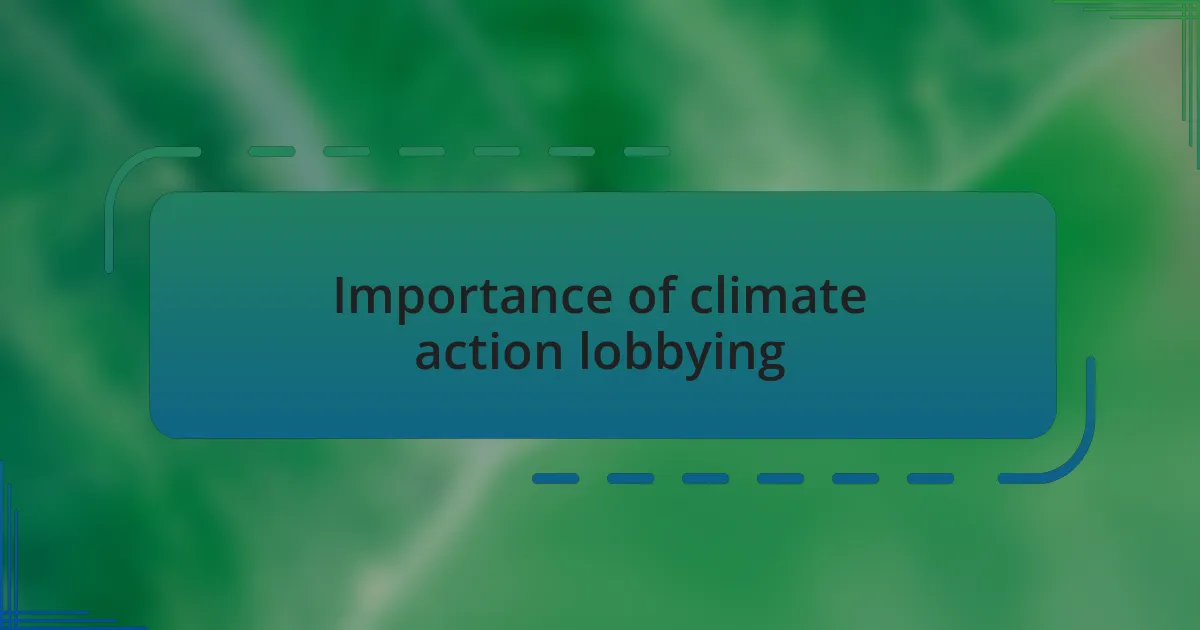
Importance of climate action lobbying
Lobbying for climate action is crucial because it translates scientific data and urgent environmental concerns into the language of policy and governance. I vividly recall a particularly impactful rally where passionate individuals came together to advocate for sustainable legislation. Standing among them, I felt such camaraderie; it reinforced my belief that when we raise our voices collectively, we amplify our calls for action, pushing climate issues to the forefront of the political agenda.
The importance of climate action lobbying lies in its ability to create accountability among decision-makers. I remember presenting at a local council meeting, urging officials to commit to renewable energy targets. As I spoke, I could sense a shift in their demeanor; they realized the community was actively watching, and their decisions mattered. This awareness can motivate policymakers to prioritize climate initiatives, knowing their constituents are not just passive observers but engaged advocates for change.
Furthermore, effective lobbying fosters an informed public discourse about climate issues. I often engage my friends and family in conversations about how legislation impacts our environment. Have you ever found yourself questioning the status quo? By educating those around me and encouraging dialogue, I’ve witnessed how grassroots movements can influence policy decisions over time. It’s about making climate action a shared responsibility that resonates beyond the walls of government.
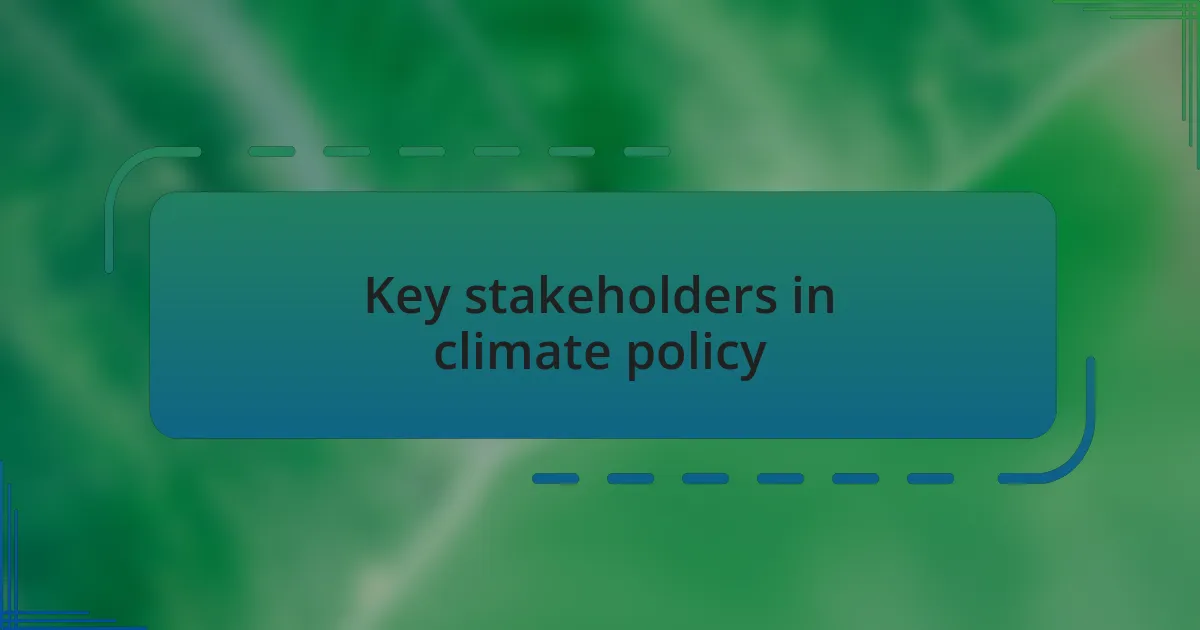
Key stakeholders in climate policy
Key stakeholders in climate policy encompass a diverse group, each playing a vital role in shaping the future of our environment. For instance, I once attended a conference where representatives from NGOs, government agencies, and private sectors gathered. Listening to their discussions, I realized how interconnected their efforts are—it’s like a complex web where each thread represents a different interest and expertise, working simultaneously toward sustainable outcomes.
Among these stakeholders, community members often seem to be the most passionate yet underrepresented. I recall participating in a town hall meeting where locals passionately voiced their concerns about pollution affecting our children’s health. Their heartfelt stories illustrate the direct impact of climate policies on everyday lives, reminding us that those most affected by climate change need to be at the heart of the conversation.
Finally, let’s not overlook the role of scientists and researchers. During my time volunteering with local environmental groups, I often met with experts who translated complex data into actionable insights. How compelling it was to witness first-hand how their findings influenced policy proposals! Engaging these stakeholders ensures that climate action is not just based on anecdotal evidence but grounded in solid scientific research, making our advocacy efforts significantly more potent.
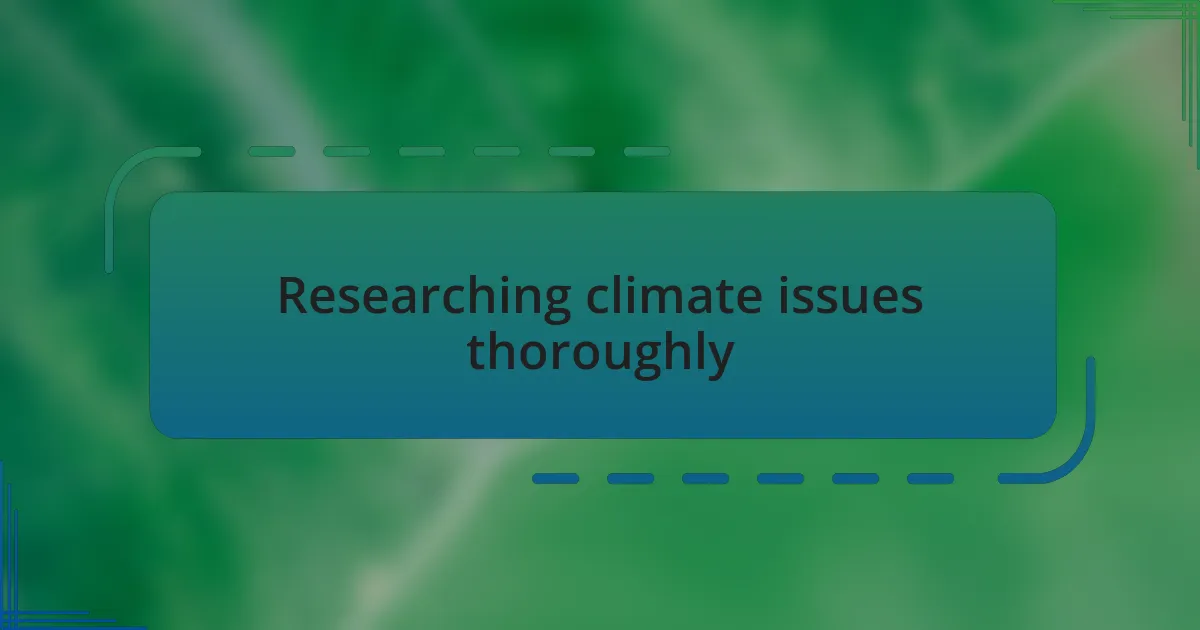
Researching climate issues thoroughly
To effectively advocate for climate policies, it’s essential to dive deep into the nuanced research surrounding climate issues. I remember spending countless hours poring over scientific studies and environmental reports, trying to separate fact from misconception. It can be overwhelming, but understanding the data equips me with arguments that resonate with policymakers and the public alike—how can you fight for change without knowing the facts inside and out?
Listening to experts is another vital strategy I’ve honed over time. I found it invaluable to attend workshops where scientists discussed their latest findings in layman’s terms. The passion they display often sparks my own enthusiasm, reminding me that behind every statistic lies a story waiting to be told. Isn’t it fascinating how a single research paper can illuminate a critical gap in public understanding? Armed with these insights, I feel more confident in communicating complex climate issues to raise awareness.
Furthermore, engaging with local communities through surveys and interviews has proven crucial in my research process. Gaining first-hand accounts of how climate change affects their lives can challenge and enrich my perspectives. I think about a woman I spoke to who lost her home to flooding; her experience became a pivotal part of my advocacy narrative. In doing this, I not only gather data but also foster a sense of urgency and personal connection to the issues at hand. How can we tailor our lobbying efforts without truly understanding the concerns of those we seek to represent?

Building coalitions for influence
Building coalitions for influence is a powerful strategy I’ve come to appreciate in my advocacy work. I’ve often found that reaching out to like-minded individuals and organizations creates a formidable force. For instance, when collaborating with local environmental groups, our collective voice became louder and more persuasive, drawing the attention of decision-makers who might have otherwise overlooked us. Isn’t it amazing how unity can amplify our messages?
Having diverse partners in these coalitions also enriches the dialogue around climate action. When I joined forces with community leaders, scientists, and business owners, it opened my eyes to perspectives I hadn’t considered before. One memorable moment was when a local business owner shared how sustainable practices helped his bottom line; this narrative was crucial in shifting the conversation to how climate action can be economically beneficial. How often do we overlook these success stories when advocating for policy change?
By building strong coalitions, we can elevate our influence and create a ripple effect in the broader community. I recall a campaign where our collaborative effort not only raised awareness but also resulted in tangible policy changes. The energy in those meetings was palpable; the excitement fueled my commitment to our cause. Isn’t it inspiring to think that together, we can shape a better future for our planet?

Communicating messages clearly
Clear communication is the bedrock of effective lobbying. I remember a time when I was preparing a presentation for a city council meeting. I focused on simplifying complex scientific data into relatable language. By using everyday examples—like how rising temperatures affect local wildlife—I could see the council members’ eyes light up. It’s fascinating to realize that when we speak in a way that resonates with our audience, we not only grab their attention, but we also foster understanding.
When crafting messages, I’ve learned to be concise yet compelling. During a recent campaign, I adopted the “elevator pitch” approach, honing my main arguments to fit within a couple of minutes. It made a significant difference. I observed that when I delivered my points clearly and confidently, even those who were initially indifferent began to engage. Isn’t it amazing how brevity can be a powerful tool?
Visual aids can serve as a bridge between words and understanding. I once utilized infographics in a community workshop to illustrate the impact of climate change in our area. The combination of visuals and straightforward language transformed a dense topic into something accessible. By making the complexities of climate action easy to visualize, I witnessed participants’ enthusiasm grow. How often do we miss opportunities to inspire action simply because we present information in a convoluted way?
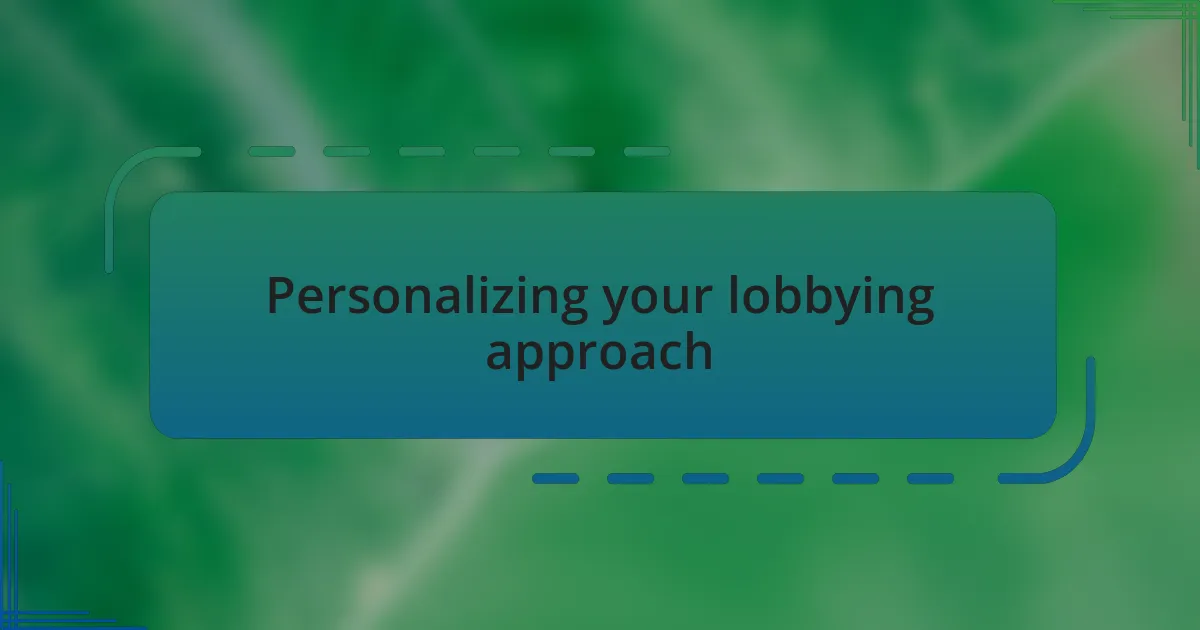
Personalizing your lobbying approach
Personalizing your lobbying approach is all about making those connections that matter. I recall a particular meeting with local officials when I shared a personal story about my grandfather, a farmer whose land has been impacted by unpredictable weather patterns. The room fell silent, and I could see the shift; they were no longer just hearing statistics—they were relating to a human experience. This kind of storytelling not only humanizes the issue but makes it more compelling for those who might not feel directly affected.
One technique I’ve found effective is tailoring my message to align with the interests of the audience. For instance, when speaking to a business group, I emphasized the economic opportunities tied to renewable energy investments. Their initial skepticism faded as I discussed how green initiatives could lead to job creation in our community. Doesn’t it make sense to frame our arguments in a way that resonates with their priorities and values?
Engaging with individuals on a personal level can also involve understanding their backgrounds and motivations. I remember attending a committee session where I took the time to research the interests of each member beforehand. When I addressed their specific concerns—like local air quality in neighborhoods—their engagement noticeably increased. Have you ever noticed how people are more willing to listen when they feel their issues are being acknowledged? Creating that connection can transform a standard lobbying effort into a meaningful dialogue.